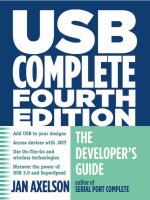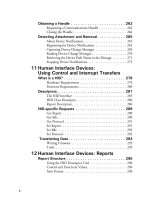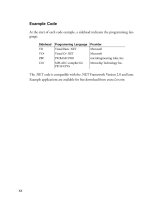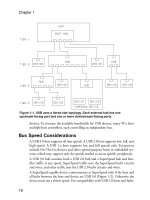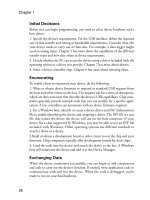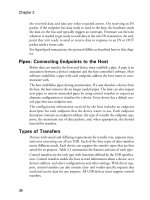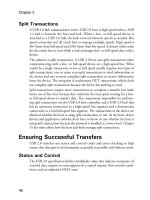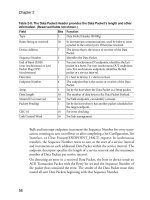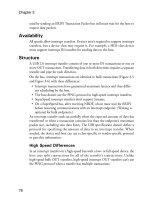USB Complete fourth- P6 pps
Bạn đang xem bản rút gọn của tài liệu. Xem và tải ngay bản đầy đủ của tài liệu tại đây (197.81 KB, 10 trang )
Chapter 1
26
+PKVKCN&GEKUKQPU
Before you can begin programming, you need to select device hardware and a
host driver:
1. Specify the device’s requirements. For the USB interface, define the required
rate of data transfer and timing or bandwidth requirements. Consider what else
your device needs to carry out its function. For example, a data logger might
need an analog input. Chapter 3 has more about the capabilities of the different
transfer types and how they relate to device requirements.
2. Decide whether the PC can access the device using a driver included with the
operating system or a driver you provide. Chapter 7 has more about drivers.
3. Select a device controller chip. Chapter 6 has more about selecting chips.
'PWOGTCVKPI
To enable a host to enumerate your device, do the following:
1. Write or obtain device firmware to respond to standard USB requests from
the host and other events on the bus. The requests ask for a series of descriptors,
which are data structures that describe the device’s USB capabilities. Chip com-
panies generally provide example code that you can modify for a specific appli-
cation. A few controllers can enumerate with no device firmware required.
2. For a Windows host, identify or create a device driver and INF (information)
file to enable identifying the device and assigning a driver. The INF file is a text
file that names the driver the device will use on the host computer. If your
device fits a class supported by Windows, you may be able to use an INF file
included with Windows. Other operating systems use different methods to
match a driver to a device.
3.Build or obtain a development board or other circuit to test the chip and your
firmware. Chip companies typically offer development boards for their chips.
4. Load the code into the device and attach the device to the bus. A Windows
host will enumerate the device and add it to the Device Manager.
'ZEJCPIKPI&CVC
When the device enumerates successfully, you can begin to add components
and code to carry out the device’s function. If needed, write application code to
communicate with and test the device. When the code is debugged, you’re
ready to test on your final hardware.
USB Basics
27
75$(TGSWGPVN[#UMGF3WGUVKQPU
USB 3.0 is a major update to the USB specification. This section is for those
who are familiar with USB 2.0 and want to know what’s new.
(GCVWTGU
USB 3.0 incorporates many new features while continuing to support USB 2.0.
Does USB 3.0 replace USB 2.0?
No. USB 3.0 defines a new SuperSpeed bus that operates parallel to the USB
2.0 bus. Devices that don’t support SuperSpeed should continue to comply
with USB 2.0. SuperSpeed devices comply with USB 3.0 when operating at
SuperSpeed and comply with USB 2.0 when operating at a lower speed. USB
3.0 also relies on USB 2.0 to define many aspects of the interface that apply to
all speeds, including transfer types, descriptors, and bus topology.
The introduction of USB 3.0 thus differs from the change from USB 1.1 to
USB 2.0. When USB 2.0 was released, USB 1.1 became obsolete, and USB 2.0
became the current specification for low, full, and high-speed devices. In con-
trast, USB 3.0 supplements, but doesn’t replace, USB 2.0.
What devices will benefit from USB 3.0?
The first devices will likely be mass storage. A USB-IF device working group is
developing a Mass Storage USB Attached SCSI Protocol (UASP) for efficient
transfers at SuperSpeed (and improved efficiency at other speeds). Video and
power-sensitive applications will also benefit from USB 3.0.
How fast is USB 3.0?
The SuperSpeed bus has a signaling rate (the speed of the bits on the wires) of 5
Gb/s, which is over 10× faster than high-speed USB. Unlike USB 2.0, Super-
Speed has a pair of wires for each direction, so data can travel in both directions
at the same time. After encoding and other overhead, the bus can carry around
400 MB/s of application data in each direction.
Other features that can increase data throughput include these:
• Endpoints can asynchronously (without waiting for the host to request the
information) notify the host when they have data to send. The host thus
doesn’t have to use up bandwidth polling endpoints that have nothing to
send.
• Bulk transfers can use a streaming protocol for improved performance.
Chapter 1
28
What stays the same?
These features remain essentially unchanged in USB 3.0:
• Tiered star topology.
• Four transfer types (control, bulk, interrupt, isochronous).
• Use of descriptors to provide device information. (USB 3.0 adds new
descriptors and adds new information in some fields in descriptors defined
in USB 2.0.)
• Device classes and many class drivers.
• Low, full, and high-speed protocols and cabling for these speeds.
What changes besides the new bus speed?
Besides the 5-Gbps bus speed, other changes with USB 3.0 include these:
• Direct routing. Hubs route downstream traffic only to the receiving device
rather than to every SuperSpeed-capable port.
• No polling. When a host requests data from a SuperSpeed, non-isochro-
nous endpoint that is busy or has no data, the endpoint returns Not Ready
(NRDY). The host can then leave the endpoint alone until the device sends
an Endpoint Ready (ERDY) notification indicating that the endpoint has
data to send.
• New, aggressive power-saving modes and protocols.
• More bus current available to devices.
• Support for bursts, where a host or device sends multiple data packets with-
out waiting for each previous packet’s acknowledgement.
• Streaming on bulk endpoints. Multiple, independent data streams can use
the same endpoint with a dedicated buffer for each stream.
%QORCVKDKNKV[
USB 3.0 is backwards compatible with USB 2.0.
Will USB 1.x and USB 2.0 devices work with USB 3.0 hosts?
Yes. A USB 3.0 host has a USB 2.0 bus in parallel with a SuperSpeed bus.
Will USB 3.0 devices work with USB 2.0 or 1.x hosts?
Sometimes. Every SuperSpeed device must also support a USB 2.0 speed but
doesn’t have to fully function at that speed. A device that can’t perform its func-
tion at the lower speed informs the host that the device requires USB 3.0 to
function. A USB 3.0 device that supports only SuperSpeed and high speed
won’t work with a USB 1.x host or a USB 1.x upstream hub.
USB Basics
29
What will change in host software?
The operating system must provide a driver for the USB 3.0 host controller.
Class and device drivers that support isochronous transfers are likely to require
changes to support SuperSpeed.
What changes do I need to make to a USB 2.0 device to comply with USB
3.0?
The USB 3.0 specification doesn’t apply to USB 2.0 devices. Devices that don’t
support SuperSpeed should continue to comply with USB 2.0.
Can a low-, full-, or high-speed device use USB 3.0’s higher bus currents?
No. SuperSpeed devices should comply with USB 3.0 when operating at Super-
Speed and comply with USB 2.0 when operating at a lower speed. A
high-power device that can operate at both SuperSpeed and high speed can
draw 900 mA at SuperSpeed but only 500 mA at high speed.
Must USB 3.0 hubs support all speeds?
Yes. A USB 3.0 hub contains a SuperSpeed hub and a USB 2.0 hub that share
power and ground lines and logic to control power to the bus. The hub enu-
merates as two devices, a SuperSpeed hub on the SuperSpeed bus and a USB
2.0 hub on the USB 2.0 bus.
Can a USB 3.0 device communicate at multiple speeds at the same time?
No, except for hubs, each USB 3.0 device communicates at the highest speed
supported by the device, the host, and the hubs between them.
%CDNGU
USB 3.0 defines new cables and connectors.
Can I use USB 2.0 cables with a SuperSpeed host or device?
Yes, for traffic at USB 2.0 speeds. USB 2.0 cables fit USB 3.0 receptacles but
don’t have wires to carry SuperSpeed traffic.
Can I use a USB 3.0 cable with a USB 2.0 host?
Yes. The USB 3.0 Standard-A plug fits the USB 2.0 Standard-A receptacle, so
you can use a USB 3.0 cable to attach a USB 3.0 device to a USB 2.0 host. The
device will communicate at a USB 2.0 speed.
Can I use USB 3.0 cable with a USB 2.0 device?
No. A USB 3.0 cable has a USB 3.0 Standard-B or USB 3.0 Micro-B plug, and
these plugs don’t fit USB 2.0 receptacles.
Chapter 1
30
What is the maximum cable length?
The USB 3.0 specification defines performance requirements but not maxi-
mum cable length. In practical terms the limit is 3 m using 26 AWG wires for
data and 22 AWG wires for power.
Can two SuperSpeed hosts connect directly to each other?
USB 3.0 defines a new cable with a USB 3.0 Standard-A plug on each end. The
cable is intended for debugging and other host-to-host applications with driver
support. The SuperSpeed wires cross-connect, routing each output to its corre-
sponding input. The cable doesn’t contain wires for V
BUS, D+, or D The
cable won’t hurt USB 2.0 hosts because the only line that connects on these
hosts is GND.
2QYGT
USB 3.0 provides both more power and more power-saving options to devices.
How much bus power can devices draw?
A USB 3.0 host or hub can provide up to 900 mA to high-power SuperSpeed
devices and up to 150 mA to low-power SuperSpeed devices. When operating
at low, full, or high speed, USB 2.0’s limits apply: high power devices can draw
up to 500 mA, and low power devices can draw up to 100 mA.
What other new power capabilities does USB 3.0 define?
A USB 3.0 device can have a Powered-B receptacle with two extra contacts that
enable the device to provide up to 5V at 1A to a device such as a Wireless USB
adapter. The adapter thus doesn’t need its own power supply. In a wired con-
nection to a host or hub, the extra contacts are unused.
31
+PUKFG75$6TCPUHGTU
This chapter looks at the elements that make up a USB transfer. You don’t need
to know every detail about USB transfers to get a project up and running, but
understanding something about how the transfers work can help in deciding
which transfer types a device should use, writing device firmware, and debug-
ging.
6TCPUHGT$CUKEU
To send or receive data, a host initiates a USB transfer. Each transfer uses a
defined format to send data, addressing information, error-detecting bits, and
status and control information. The format varies with the transfer type and
direction.
6JG'UUGPVKCNU
Every USB communication (with one exception in USB 3.0) is between a host
and a device. The host manages traffic on the bus, and the device responds to
communications from the host. An endpoint is a device buffer that stores
received data or data to transmit. Each endpoint has a number, a direction, and
Chapter 2
32
a maximum number of data bytes the endpoint can send or receive in a transac-
tion.
Each USB transfer consists of one or more transactions that can carry data to or
from an endpoint. A USB 2.0 transaction begins when the host sends a token
packet on the bus. The token packet contains the target endpoint number and
direction. An IN token packet requests a data packet from the endpoint. An
OUT token packet precedes a data packet from the host. In addition to data,
each data packet contains error-checking bits and a Packet ID (PID) with a
data-sequencing value. Many transactions also have a handshake packet where
the receiver of the data reports success or failure of the transaction. For USB 3.0
transactions, the packet types and protocols differ, but the transactions contain
similar addressing, error-checking, and data-sequencing values along with the
data.
USB supports four transfer types: control, bulk, interrupt, and isochronous. In
a control transfer, the host sends a defined request to the device. On device
attachment, the host uses control transfers to request a series of data structures
called descriptors from the device. The descriptors provide information about
the device’s capabilities and help the host decide what driver to assign to the
device. A class specification or vendor can also define requests.
Control transfers have up to three stages: Setup, Data (optional), and Status.
The Setup stage contains the request. When present, the Data stage contains
data from the host or device, depending on the request. The Status stage con-
tains information about the success of the transfer. In a control read transfer,
the device sends data in the Data stage. In a control write transfer, the host
sends data in the Data stage, or the Data stage is absent.
The other transfer types don’t have defined stages. Instead, higher-level software
defines how to interpret the raw data. Bulk transfers are the fastest on an other-
wise idle bus but have no guaranteed timing. Printers and USB virtual
COM-port data use bulk transfers. Interrupt transfers have guaranteed maxi-
mum latency, or time between transaction attempts. Mice and keyboards use
interrupt transfers. Isochronous transfers have guaranteed timing but no error
correcting. Streaming audio and video use isochronous transfers.
2WTRQUGUHQT%QOOWPKECVKQP
USB communications fall into two general categories: communications that
help to identify and configure the device and communications that carry out
the device’s purpose. During enumeration, the host learns about the device and
Inside USB Transfers
33
requests a configuration that prepares the device to perform its function. When
enumeration is complete, the host can send and request data as needed to carry
out the device’s purpose.
During enumeration, the device’s firmware responds to a series of standard
requests from the host. The device must decode the requests, return requested
information, and take other actions to carry out the requests.
On Windows PCs, the operating system performs enumeration with no appli-
cation programming required. The first time a device attaches to a system, the
Plug-and-Play (PnP) Manager must locate an INF file that identifies the name
and location of one or more driver files to assign to the device. If the required
files are available and the firmware functions correctly, the enumeration process
is generally invisible to users. Chapter 9 has more about device drivers and INF
files.
After the host has enumerated the device and a device driver has been assigned
and loaded, application communications can begin. At the host, applications
can use Windows API functions or other software components to read and
write to the device. At the device, transferring data typically requires either plac-
ing data to send in an endpoint’s transmit buffer or retrieving received data
from an endpoint’s receive buffer, and on completing a transaction, ensuring
that the endpoint is ready for another transaction. Most devices also require
firmware support for handling errors and other events.
/CPCIKPI&CVCQPVJG$WU
The host schedules the transfers on the bus. A USB 2.0 host controller manages
traffic by dividing time into 1-ms frames at low and full speeds and 125-
µs
microframes at high speed. The host allocates a portion of each (micro)frame to
each transfer. Each (micro)frame begins with a Start-of-Frame (SOF) timing
reference. The SuperSpeed bus doesn’t use SOFs, but a USB 3.0 host schedules
SuperSpeed transfers within 125-
µs bus intervals. A USB 3.0 host also sends
timstamp packets once every bus interval to all SuperSpeed ports that aren’t in a
low-power state.
Each transfer consists of one or more transactions. Control transfers always
have multiple transactions because they have multiple stages, each consisting of
one or more transactions. Other transfer types use multiple transactions when
they have more data than will fit in a single transaction. Depending on how the
host schedules the transactions and the speed of a device’s response, the transac-
Chapter 2
34
tions in a transfer may all be in a single (micro)frame or bus interval, or the
transactions may be spread over multiple (micro)frames or bus intervals.
Every device has a unique address assigned by the host, and all data travels to or
from the host. Except for remote wakeup signaling, everything a USB 2.0
device sends is in response to receiving a packet sent by the host. Because multi-
ple devices can share a data path on the bus, each USB 2.0 transaction includes
a device address that identifies the transaction’s destination.
SuperSpeed devices can send status and control information to the host without
waiting for the host to request the information. Every SuperSpeed Data Packet
and Transaction Packet includes a device address. SuperSpeed also uses Link
Management Packets packets that travel only between a device and the nearest
hub and thus don’t need addressing information.
'NGOGPVUQHC6TCPUHGT
Every USB transfer consists of one or more transactions, and each transaction
in turn contains packets of information. To understand transactions, packets,
and their contents, you also need to understand endpoints and pipes. So that’s
where we’ll begin.
'PFRQKPVUVJG5QWTEGCPF5KPMQH&CVC
All bus traffic travels to or from a device endpoint. The endpoint is a buffer that
typically stores multiple bytes and consists of a block of data memory or a regis-
ter in the device-controller chip. The data stored at an endpoint may be
received data or data waiting to transmit. The host also has buffers that hold
received data and data waiting to transmit, but the host doesn’t have endpoints.
Instead, the host serves as the source and destination for communications with
device endpoints.
An endpoint address consists of an endpoint number and direction. The num-
ber is a value in the range 0–15. The direction is defined from the host’s per-
spective: an IN endpoint provides data to send to the host and an OUT
endpoint stores data received from the host. An endpoint configured for control
transfers must transfer data in both directions, so a control endpoint consists of
a pair of IN and OUT endpoint addresses that share an endpoint number.
Every device must have endpoint zero configured as a control endpoint. There’s
rarely if ever a need for additional control endpoints.
Inside USB Transfers
35
For other transfer types, data flows in one direction, though status and control
information can travel in the opposite direction. A single endpoint number can
support both IN and OUT endpoint addresses. For example, a device might
have endpoint 1 IN for sending data to the host and endpoint 1 OUT for
receiving data from the host.
In addition to endpoint zero, a full- or high-speed device can have up to 30
additional endpoint addresses (1–15 IN and OUT). A low-speed device can
have at most two additional endpoint addresses which can be two IN, two
OUT, or one in each direction.
6TCPUCEVKQP6[RGU
Every USB 2.0 transaction begins with a packet that contains an endpoint
number and a code that indicates the direction of data flow and whether the
transaction is initiating a control transfer:
As with endpoint directions, the naming convention for IN and OUT transac-
tions is from the perspective of the host. In an IN transaction, data travels from
the device to the host. In an OUT transaction, data travels from the host to the
device.
A Setup transaction is like an OUT transaction because data travels from the
host to the device, but a Setup transaction is a special case because it initiates a
control transfer. Devices need to identify Setup transactions because these are
the only transactions that devices must always accept and because the device
must identify and respond to the request contained in the received data. Any
transfer type may use IN or OUT transactions.
In every USB 2.0 transaction, the host sends an addressing triple that consists of
a device address, an endpoint number, and endpoint direction. On receiving an
OUT or Setup packet, the endpoint stores the data that follows the packet, and
the device hardware typically triggers an interrupt. Firmware can then process
6TCPUCEVKQP
6[RG
5QWTEGQH
&CVC
6[RGUQH6TCPUHGTU
VJCV7UGVJG
6TCPUCEVKQP6[RG
%QPVGPVU
IN device all data or status
information
OUT host all data or status
information
Setup host control a request
